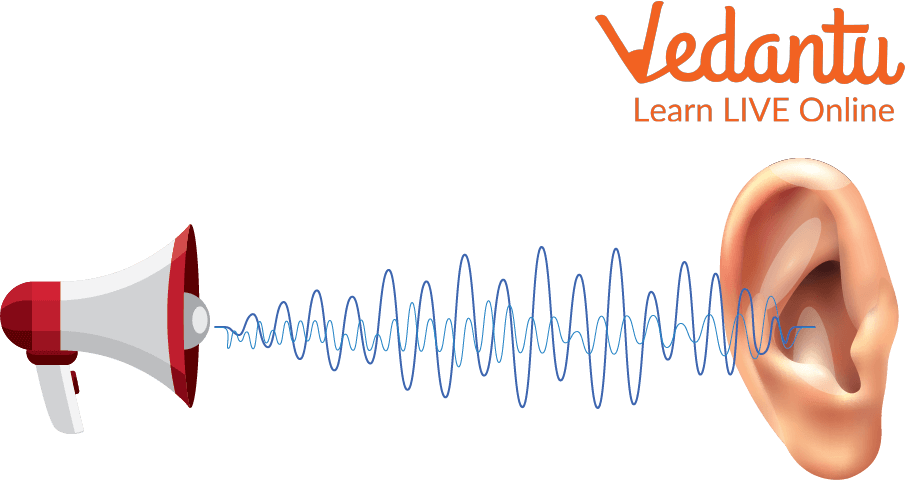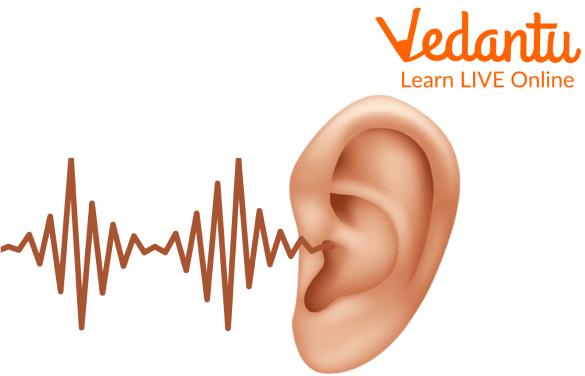




Why Do We Hear Sound? Understanding Its Nature and Uses
Sound is a form of energy that is transmitted through the air in the form of waves. It is created by vibrations, which enter the ear and cause tiny hairs to vibrate. The brain then interprets these vibrations as sound. The human ear is able to hear sound waves from 20-20000 Hz. The frequency of a wave determines its pitch or tone, while the amplitude determines its loudness.
In this article, we will learn everything about sound. Sound waves and vibrations are a few of the important topics which will be covered in this article. So let’s have a look.

Sound Waves
What is Vibration of Sound?

Vibration of Sound
The vibration of sound is the natural phenomenon by which sound waves create pressure variations in the air.
Vibration is a longitudinal oscillation at constant speed and direction. There are a few types of longitudinal oscillation. The one we are going to focus on is sound vibration. When a sound wave passes through materials, it causes individual atoms in the matter to vibrate. If the atoms vibrate at certain frequencies, then we get different types of waves. The pressure variations in the air are created by a vibrating object and then radiated outwards as longitudinal waves.
A sound is a form of energy that propagates through matter, or space, with no mass. Sound waves are vibrations that typically propagate at a velocity of approximately 343 meters per second through the medium they occupy and produce vibrations on an object they encounter.

Sound Waves to the Ear
How is Sound Produced?
Sound is also called "sound pressure", "audio", and "audible". Sound is everything that makes our world go round. There are two sound waves: air pressure waves and muscle contractions. Each wave moves in one direction at a certain speed, either high or low. If there is no obstacle to stop it, then the wave will continue to move until it can't move anymore. Sound waves are transmitted by air molecules vibrating at high speed and with higher frequencies than low frequencies.
Sound is the only sense that humans can’t live without. It is important for our everyday lives, and it shapes our perception of the world. Sound is a vibration that moves through a medium, like air or water. When we hear a sound, it causes our eardrums to vibrate. The eardrums send signals to the brain about what we are hearing. There are many sound waves: infrasonic waves, ultrasonic waves, and audible waves. Sound can be measured by its intensity, frequency, and wavelength.
What are Sound Waves?
The sound waves are created by a vibrating object, such as an animal’s vocal cords, a person’s vocal cords or an instrument like a guitar string. The vibrations cause pressure waves in the air, which travel away from their source and cause nearby objects to vibrate in response.
There are two types of sound waves: longitudinal waves and transverse waves. Transverse waves are the ones we hear when we play the guitar or clap our hands. Longitudinal waves are the ones that cause vibrations, movement or dancing. It is called longitudinal because the atoms in materials move along with each other longer than at right angles (they point in opposite directions). However, this is not always true, as this depends on how long they vibrate since some vibrations will be shorter than others.
Sound waves are generated by vibrating objects like musical instruments and speakers. There are different types of sounds, such as mechanical, natural, and human-made.
Types of Sound

Different Sources of Sound Around Us
Sound is a vibration that propagates through a medium such as air or water. It is why we can hear things, and it can be detected by humans with their ears. There are many different types of sound: Mechanical sound, sound from a musical instrument, sound from the human voice, sound from an animal or insect, and sound from nature.
There are four main types of sounds:
Mechanical Sound: The sound of machines and tools.
Industrial Sound: The sounds of factories and industrial work.
Electronic Sound: The sounds from electronic devices like computers and cell phones.
Musical Sound: The sounds that are part of music, such as singing or playing an instrument.
Sound can also be categorised on the basis of frequency:
Infrasonic sound is sound with a frequency below 20 hertz.
Ultrasonic sound is sound with a frequency above 20 kilohertz.
Summary
In this article, we learned what is sound and we also learned some interesting facts about sound. Sound is one of the five senses that we use to perceive our surroundings. It is a physical phenomenon that can be perceived by the ear and heard as sound. A sound is a form of energy which propagates through the air or other medium.
The speed of sound is measured in meters per second, and it's about 343 meters per second at 20°C. The speed of sound is not the same for all substances. It can be slower or faster than 343 meters per second, depending on the density, temperature, and pressure of the substance through which it is travelling. This article helped us in learning about sound and its characteristics. Now, we are in a position to answer questions about sound and its properties.
FAQs on What Is Sound? Concept, Definition & Examples
1. How is sound produced in the first place?
Sound is produced by vibrating objects. When something vibrates, it causes the particles in the medium around it (like air) to move back and forth. This movement creates a wave of energy that travels to our ears, which we perceive as sound. For example, a guitar string vibrates when you pluck it.
2. What is sound in simple scientific terms?
In science, sound is defined as a form of energy that travels as waves through a medium (solid, liquid, or gas). It cannot travel through a vacuum because there are no particles to carry the vibrations. Our brain interprets these waves when they are detected by our ears.
3. How does sound travel from one place to another?
Sound travels when vibrations are passed from one particle to another in a chain reaction. Imagine a line of dominoes; when you push the first one, it knocks over the next, and so on. Similarly, a vibrating object pushes nearby air particles, which then push the particles next to them, carrying the sound wave forward.
4. What are the main characteristics that describe a sound?
The two primary characteristics of a sound wave are:
- Amplitude: This determines the sound's loudness or volume. A larger amplitude means a louder sound.
- Frequency: This determines the sound's pitch. A higher frequency results in a higher-pitched or more shrill sound.
5. What is the actual difference between the loudness and pitch of a sound?
Loudness and pitch are distinct properties. Loudness is related to the amplitude or intensity of the sound wave and describes whether a sound is loud or faint. Pitch is related to the frequency of the sound wave and describes whether a sound is high (like a whistle) or low (like a drum).
6. Why can't you hear any sound in outer space?
You cannot hear sound in space because it is a near-perfect vacuum, meaning it has almost no particles. Sound requires a medium, such as air, water, or a solid, for its waves to travel through. Without particles to vibrate and pass the energy along, sound simply cannot exist or travel.
7. How does the science of sound relate to music?
Music is a special application of sound. It is created by combining sounds with specific, organised patterns of pitch (melody) and loudness (dynamics). Different musical instruments produce unique sound qualities, or timbres, allowing us to distinguish between a piano and a violin even when they play the same note.
8. What makes a sound considered 'music' versus just 'noise'?
The key difference is the nature of the vibrations. Music is typically made of sounds with regular, repeating vibrations that create a pleasant and organised pattern. Noise, on the other hand, consists of irregular and disorganised vibrations with no clear pattern, which our brain often perceives as unpleasant or jarring.









